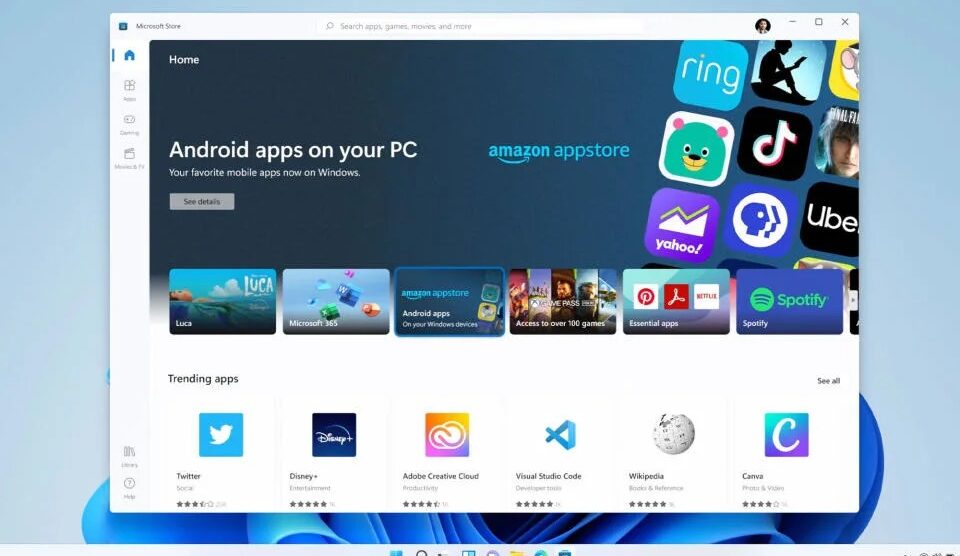In an unexpected turn of events, Microsoft has made the decision to end support for Android apps on its Windows operating system. This move effectively pulls the plug on the Windows Subsystem for Android (WSA), a feature that allowed users to run Android applications natively on Windows 11 devices.
The announcement has sent shockwaves through the tech community, leaving many users wondering about the future of their favorite Android apps on Windows and the implications of this decision for Microsoft’s overall strategy.
The End of an Era: No More Android Apps on Windows
Microsoft’s decision to discontinue support for Android apps on Windows comes as a surprise to many, especially considering the company’s recent efforts to bridge the gap between mobile and desktop operating systems. The Windows Subsystem for Android, introduced with Windows 11, was seen as a significant step towards making Windows more versatile and user-friendly for those accustomed to mobile apps.
According to Microsoft, existing users who have already downloaded Android apps through the WSA will be able to continue using them until March 5, 2025. However, after that date, no new apps will be available for installation, and the WSA will cease to function altogether.
Microsoft’s Rationale: Evolving Customer Needs
In its official statement, Microsoft cited “evolving customer needs” as the primary reason behind the decision to end support for Android apps on Windows. The company did not provide further details on what specific changes in customer requirements led to this move.
Some industry experts speculate that Microsoft may have realized that the demand for Android apps on Windows was not as high as initially anticipated. Others suggest that the company may be shifting its focus away from making Windows more touch-friendly, a strategy that was closely tied to the integration of Android apps.
The Amazon Appstore Factor
Another potential factor in Microsoft’s decision could be the performance of the Amazon Appstore, which served as the primary source for Android apps on Windows 11. Some users reported a preference for the Google Play Store, which offers a wider selection of apps and more frequent updates.
It is possible that Microsoft found the Amazon Appstore integration to be less successful than hoped, leading to the decision to discontinue the feature altogether.

Impact on Windows Users
For Windows users who have come to rely on Android apps for productivity, entertainment, or other purposes, the end of support for the Windows Subsystem for Android is likely to be a significant inconvenience.
Finding Alternatives
Users who have grown accustomed to using Android apps on their Windows devices will need to find alternative solutions once support ends on March 5, 2025. This may involve searching for Windows-native applications that offer similar functionality or exploring web-based alternatives that can be accessed through a browser.
Potential Workflow Disruptions
In some cases, the discontinuation of Android app support may lead to workflow disruptions, particularly for users who have integrated these apps into their daily routines. Businesses and individuals alike may need to reassess their processes and find new tools to fill the gaps left by the departing Android apps.
Implications for Microsoft’s Strategy
Microsoft’s decision to end support for Android apps on Windows raises questions about the company’s overall strategy and its commitment to certain initiatives.
A Blow to Mobile-Desktop Convergence
The Windows Subsystem for Android was seen as a key component of Microsoft’s efforts to bridge the gap between mobile and desktop operating systems. By allowing users to run Android apps natively on Windows, Microsoft aimed to create a more seamless and unified experience across devices.
The discontinuation of this feature suggests that Microsoft may be reevaluating its approach to mobile-desktop convergence and exploring alternative ways to meet the needs of users in an increasingly mobile-centric world.
The Future of the Windows Subsystem for Linux
Microsoft’s decision to end support for Android apps on Windows also raises questions about the future of the Windows Subsystem for Linux (WSL). Like the WSA, the WSL allows users to run Linux applications natively on Windows, catering to developers and power users who require access to Linux tools and environments.
While Microsoft has not announced any changes to the WSL, the discontinuation of the WSA may lead some to speculate about the long-term viability of the Linux subsystem and Microsoft’s commitment to supporting alternative operating systems within Windows.
Alternatives for Affected Users
For Windows users who will no longer be able to use Android apps after March 5, 2025, there are a few alternatives to consider:
Web-Based Alternatives
Many popular Android apps have web-based counterparts that offer similar functionality. Users can access these web apps through their preferred browser on any device, including Windows PCs. While web apps may not always provide the same level of performance or offline capabilities as native apps, they can be a suitable alternative in many cases.
Switching to a Different Platform
For users who heavily rely on Android apps and find it difficult to adapt to Windows-native or web-based alternatives, switching to a different platform may be worth considering. Chromebooks and Mac computers, for example, offer native support for Android apps and may provide a more seamless experience for those who prioritize mobile app compatibility.
The Road Ahead
As Microsoft moves away from supporting Android apps on Windows, it is clear that the company is reassessing its priorities and strategies in the face of evolving user needs and market trends.
While the discontinuation of the Windows Subsystem for Android may be disappointing for some users, it is important to remember that technology is constantly evolving, and new solutions will likely emerge to fill the void left by departing features.
As users adapt to this change and explore alternative options, it will be interesting to see how Microsoft continues to shape the future of Windows and cater to the diverse needs of its user base.
Conclusion
Microsoft’s decision to end support for Android apps on Windows marks the end of an era and raises important questions about the future of mobile-desktop convergence and the company’s overall strategy.
While the discontinuation of the Windows Subsystem for Android may be inconvenient for some users, it is important to remember that there are alternatives available, such as web-based apps and switching to platforms that natively support Android applications.
As we move forward, it will be crucial for Microsoft to communicate its vision for the future of Windows clearly and to continue innovating in ways that meet the ever-changing needs of its diverse user base. Only time will tell how this decision will shape the trajectory of Windows and the broader technology landscape.










Add Comment